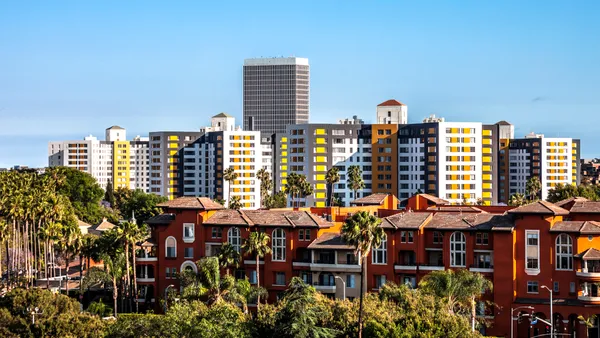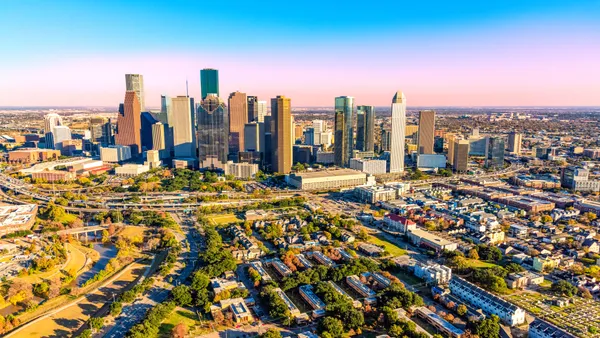Dive Brief:
- Americans spent almost 30% of their monthly income on rent in February, according to the Realtor.com Monthly Rental Report. In addition, U.S. median rent jumped 17.1% year-over-year marking the seventh month in a row of double-digit increases. However, growth did moderate from January.
- In 14 of the 50 largest U.S. markets, rents accounted for more than 30% of residents' income. Sun Belt metros, which have seen staggering rent increases over the past year, are some of the least affordable areas, according to Realtor.com.
- In February, median rent hit a new high of $1,792. Studio rents saw the largest increase, rising 17.1% to a median of $1,474. One-bedroom apartments increased 16.4% to $1,648; while two-bedrooms jumped 16.2% to $2,002.
Dive Insight:
Rents have skyrocketed even more over the past two years, jumping nearly 20%, according to Realtor.com. Other sources also showed robust pricing power for landlords. The average monthly asking rent hit a record high of $1,901 in February as it increased 15% year over year, according to Redfin.
Young Americans forming households, eviction moratoriums expiring, a tight homeownership market and people moving to new areas have pushed rent prices to all-time highs. The result of these increases is that rent costs hit 29.7% — near the advised income ratio — and stretching affordability in the process, according to Realtor.com Chief Economist Danielle Hale. There could be some cooling insight, though, she said.
"This month's report is the first in which we've seen the growth rate in rents slow, which is a positive sign for renters, but growth is still at a double-digit pace and rents are taking up a larger share of income," Hale said. "I expect that rent growth will slow to better align with income growth moving forward, but we're not quite there yet."
Local performance varies
Sun Belt metros saw the largest deterioration in affordability. The rental share of income was highest in Miami (59.5%), Los Angeles (46.0%) and Riverside, Calif. (45.9%). Half of February's least affordable metros were in the Sun Belt and three were in Florida.
Least affordable rental markets
| Metro | Rental share of income | Median rent |
| Miami | 59.5% | $2,929 |
| Los Angeles | 46.0% | $2,993 |
| Riverside | 45.9% | $2,678 |
| Tampa | 44.7% | $2,098 |
| San Diego | 42.9% | $3,008 |
| New York | 40.9% | $2,725 |
| Las Vegas | 39.6% | $1,600 |
| New Orleans | 37.2% | $1,725 |
| Orlando | 36.7% | $1,843 |
| Phoenix | 34.7% | $1,855 |
SOURCE: Realtor.com
More investment and development are on the way in some of these markets and overall apartment construction is expected to hit a 30-year high this year, which could ease affordability concerns somewhat.
But a fundamental supply-demand imbalance persists, meaning affordability concerns are here to stay.
"The U.S. is under-housed," said James McCormick, head of acquisitions and dispositions at Chicago-based apartment owner, manager and developer AMLI Residential.
Click here to sign up to receive multifamily and apartment news like this article in your inbox every weekday.











